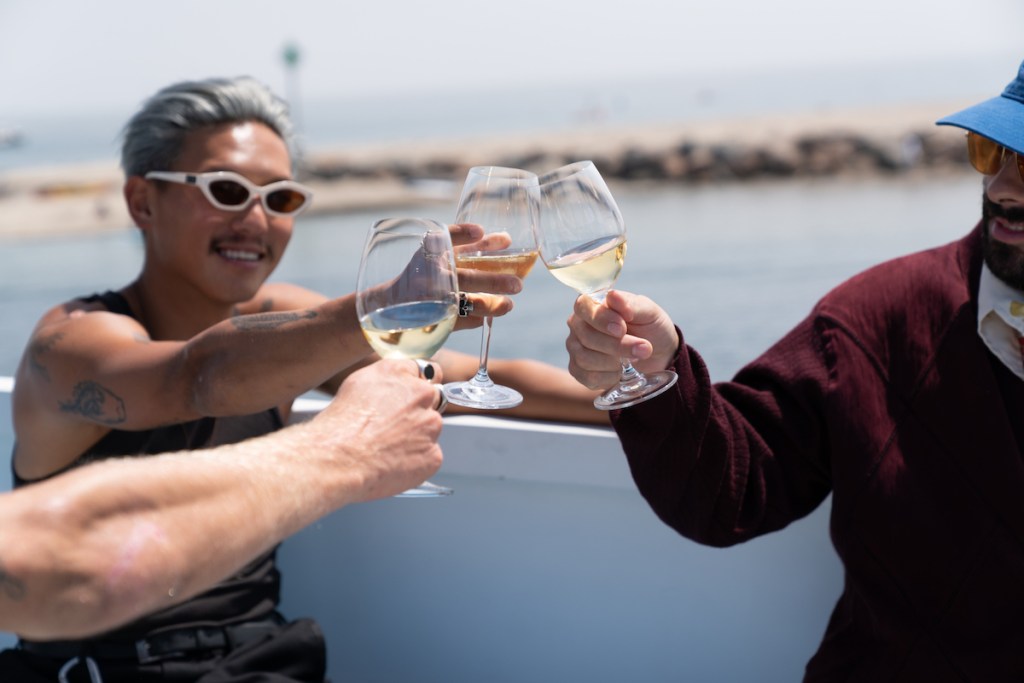A Santa Barbara–based wine-storage business has patented and begun an innovative undersea aging process, sinking hundreds of bottles to the floor of the Santa Barbara Channel and pulling up bottles encrusted with sea life — but the process of regulating the project has been a complicated one.
Ocean Fathoms began deploying the wine containers in 2016, according to a California Coastal Commission staff report. Three cages were initially put down and taken out; later, a 64-cubic-foot cage was put down in March 2019, about 70 feet down and two-thirds of a mile off the coast from Fernald Point in Summerland.
After members of the U.S. Army Corps of Engineers made California Coastal Commission staff aware of the situation in August 2020, Ocean Fathoms was served with a notice of violation in February 2021. The company then filed for an after-the-fact authorization for the initial cages put down.
Although the Coastal Commission never officially met regarding this issue, the staff report recommendation was to deny an after-the-fact authorization. One of the key arguments in the report was that the cages, approximately four feet by four feet, would harm marine life.
“The facility would adversely affect marine biological resources,” the report read, “by disturbing, crushing and smothering marine life within the facility’s installation footprint, altering the seafloor habitat within that area.”
Emanuele Azzaretto, one of the main founders of Ocean Fathoms, claims if any damage were done to the ocean by the process, it would be minimal.
“We’re trying to be as neutral as possible,” he said.
Azzaretto said he has a passion for animal conservation, working in Africa at a wildlife preserve for many years before coming to Santa Barbara.
“I’ve worked 15 years in game management; I’m sure I can work it out,” he said.
Azzaretto also said the cages are raised so that they stand on four feet, allowing any marine life to pass under them.
Azzaretto and cofounder Todd Hahn said they have wanted to work with local authorities to continue this project, but since it is the first project of its kind, it has been difficult to find the proper channel to go through.
“It’s been a push-around for a long time,” Azzaretto said, explaining that he went to the Santa Barbara Harbormaster and the United States Coast Guard to find the best point to drop the cages.
The company has some local support, most notably County Supervisor Das Williams, who said the local benefit of an innovative project is worth looking into, and that the environmental impact might not be as distressing as thought.
“I can’t yet see the environmental impact that would be negative,” Williams said. “I don’t assume the addition of strata is bad for an environment.”
Sign up for Indy Today to receive fresh news from Independent.com, in your inbox, every morning.
Earlier this year, Williams unsuccessfully sought an appointment to the Coastal Commission that went to S.B. City Councilmember Meagan Harmon. Harmon declined to comment on Ocean Fathoms specifically, but said, “The Coastal Commission has a critically important role to play in preserving and protecting our coast and our ocean, and that includes working closely with local stakeholders to ensure that the Coastal Act is upheld. Early, regular communication and engagement with the Commission is key to achieving positive outcomes — for our coast and for our whole community.”
The effect on the environment might not be as much as some worry, but the effect on the taste, Hahn claimed, is undeniable.
Most described the difference in taste as simply “different,” especially when tasting the normally aged versus the ocean-aged bottles side by side. The taste was also described as having “smoother edges,” where the lines between sweet, bold, and tart are blurred.
“The process absolutely changes the wine for the better,” said Hahn.
The bottles vary in look depending on the time of year they were put down, as well as many other factors that affect marine life. The bottles down during 2018’s 1/9 Debris Flow in Montecito were covered in worms and had a swirling pattern of debris. Bottles from the beginning of the pandemic, when fewer people were in the water or on the beaches, were encrusted with barnacles.
Each bottle has a unique character that cannot be replicated, Azzaretto said.
Ocean Fathoms’ wine is not available in stores or at any local wineries, but the company would like to work with local vineyards in the future.
“Why take it to another wine community?” Azzaretto asked.
Williams said the addition of this company could further Santa Barbara’s reputation as a premier wine-tasting destination.
“I would love it if Santa Barbara wines got on the map because of this.”
It is currently unknown when the project will be brought before the Coastal Commission again.

